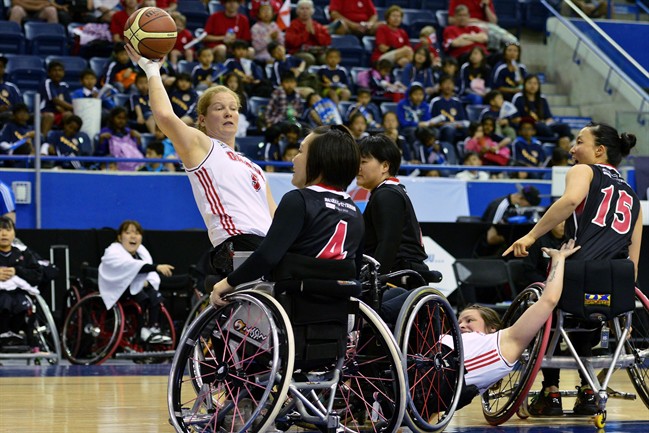TORONTO – Janet McLachlan had played for both Canada’s national basketball and rugby teams, but when an injury on the pitch left her knee in tatters, her sports career could easily have ended there.

But the 36-year-old from Vancouver was introduced to wheelchair basketball, and has become one of the world’s best women’s players.
McLachlan scored 28 points and grabbed 21 rebounds Friday as the Canadian women cruised to an 83-53 victory over Japan in their opening game of the world championships Friday.
Of all the sporting stages the six-foot player has performed on, McLachlan says international wheelchair basketball “tops them all.”
“Not just for the competition, but the competitiveness and the intelligence that’s required to play wheelchair basketball,” McLachlan said. “You’re able to use your wheelchair to stop somebody going where they want to go. You can’t do that in stand-up, you can’t just stand in front of them and be like: ‘Ha, you can’t go anywhere.’ But in wheelchair you can. It’s much more of a team game, you have to work together and that aspect of it is something I really enjoy.
“And it’s physical, it’s fast, it’s intense. We train a lot. It’s a very high-level sport. And all of those aspects kind of all come together, moreso than in this than in the others that I played.”
Katie Harnock of Elmira, Ont., added 25 points while Cindy Ouellet of Quebec City finished with 15 points and 10 assists at Ryerson University’s Mattamy Athletic Centre.
McLachlan played standup basketball for the University of Victoria, winning two Canadian university titles. She also played for Canada at the World University Games.
She switched to rugby but shredded her knee twice. The first time she blew the anterior cruciate ligament. The second time “it was the ACL, MCL, PCL, miniscus and tibial compression fracture,” she said.
A rugby teammate who played wheelchair basketball for cross-training while injured introduced her to the sport. She’s able to compete internationally in the sport because she is no longer physically able to play standup basketball.
“You submit all your medical data, the MRIs, the tests, the surgeries, the reports from your doctors. You have an exam, they test the stability of your knee,” she said.
In wheelchair basketball, players are classified according to their functional ability, from 1 to 4.5. The total number of the five players on the court can’t total more than 14.
The higher the point number, the greater the player’s functional ability. McLachlan is at the top of the scale at 4.5.
But her introduction to the sport, being someone who’d never used a wheelchair, was “very humbling.”
“Being in the chair, and not having your legs, and then to shoot — because usually you have that power, you get your shooting power from your legs — but that’s gone all of a sudden,” she said. “And your legs are part of your body, so if the ball’s over there, they just take you there. But it doesn’t work that way in a wheelchair, you have to kind of consciously make the decision … so learning the chair, being comfortable in the chair, it makes a huge difference.
“But having the basketball skills and experience going in makes a big difference as well.”
McLachlan played power forward or centre in the standup game, but at just six feet, she had to use her strength to make up for the difference in height against her opponents. In the wheelchair game, McLachlan is almost always the biggest player on the floor.
“I’m bigger in this than I ever was in standup. I have a very long torso, so when I get out on the court, especially against a team like Japan, I’m huge,” she said. “That gives me an advantage, it lets me play a different game in wheelchair than I might have been able to play in standup.”
She’s played in a men’s semi-pro league in Germany for the past couple of years where some of the men, she said, “can make a very good living at it.”
“Some of the rest of us just kind of get by,” she added. “But the experience and being a part of something like that is worth far more than any paycheque you’d ever get.”
Similar to the international classification system, female players in the men’s semi-pro league play at a level 1.5 points lower than they normally would.
The Canadian women won bronze at the 2010 world championships after winning gold in 2006, 2002, 1998 and 1994. However, Canada finished a disappointing sixth at the 2012 London Paralympics.
“London was a bit of an anomaly, we considered ourselves one of the top three teams in that tournament and we ended up losing in a tough tiebreaker situation,” said Canadian head coach Bill Johnson. “Things happened and it was a really tough experience. I think it’s helped to galvanize us as a little bit for this tournament and we’re ready to compete at our best at this tournament.”
The Canadians will face Brazil on Saturday before taking on China on Sunday and the top-ranked Germans on Monday. Canada will cap pool play Tuesday against Great Britain.
Twelve countries are competing in the tournament, which is also being used as a test event for the Toronto 2015 Parapan Am Games.
The gold-medal game is June 28.

Comments